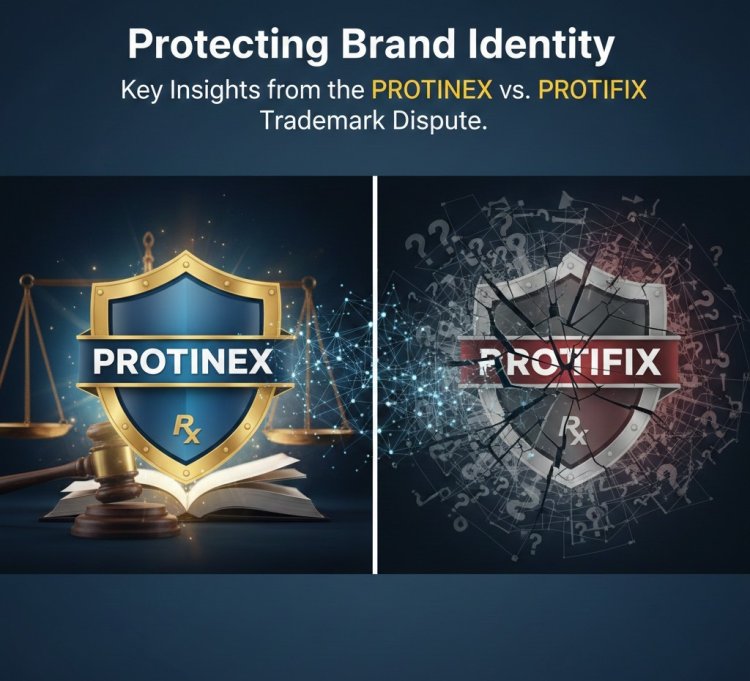Protecting Brand Identity: Key Insights from the PROTINEX vs. PROTIFIX Trademark Dispute
The Calcutta High Court, in Danone Asia Pacific Holdings v. Syed Jawed Mohsin, cancelled the mark "PROTIFIX" for deceptive similarity to the well-known "PROTINEX." The court found lack of genuine use, bad-faith adoption, and a high likelihood of consumer confusion. This case reinforces the importance of trademark vigilance, brand protection, and thorough searches before adopting new marks.

Introduction
In Danone Asia Pacific Holdings Pte. Ltd. v. Syed Jawed Mohsin & Anr., IPDATM/5/2024, the High Court at Calcutta, under the guidance of Hon'ble Justice Ravi Krishan Kapur, heard the matter on September 24, 2025. The petitioner, Danone Asia Pacific, claims a long history of using and registering the trademark "PROTINEX," a popular protein supplement since 1957 in India. They assert that they have acquired all rights to this trademark through various assignments from prior owners. However, in late September 2024, they noticed the respondents' product, "PROTIFIX," which they allege bears a deceptively similar name and appearance. To address this issue, Danone filed for rectification and cancellation of the "PROTIFIX" mark, arguing that it hasn't been used genuinely and could confuse the public due to its similarity. The respondents countered by claiming that "Proti" is a generic term in the industry and that their packaging is distinct. The central issues at stake are whether "PROTIFIX" is indeed confusingly similar to "PROTINEX," whether the respondents have genuinely used their trademark, and whether their registration should be cancelled under the relevant sections of the Trade Marks Act, 1999. The details of the respondent’s mark are given below.
|
S.No. |
Mark |
Application No. |
Class |
|
1. |
|
3592264 |
5 |
Comparison between both the marks below.
|
Petitioner’s mark |
Respondent’s mark |
|
|
|
In the dispute, the petitioner highlights their long-standing use and established market reputation associated with the mark "PROTINEX." They argue that the respondent's use of "PROTIFIX" is quite similar in appearance, structure, and sound, which could potentially confuse consumers. Additionally, the petitioner points out that the respondent has not provided credible evidence of genuine use for "PROTIFIX," mentioning that invoices suggest sales were made by unrelated parties. They also bring attention to the fact that the trade dress and product presentation of "PROTIFIX" are strikingly similar, raising further concerns. On the other hand, the respondent contends that the term "Proti" is generic and widely used in similar goods, arguing that the petitioner shouldn't have exclusive rights over such a common term. They claim that there are noticeable differences in color schemes, packaging, and overall trade dress that distinguish their product. This back-and-forth highlights the complexities of branding and consumer perception in the marketplace.
To know more about this you can follow the link below:
In discussing the legal principles related to trademarks, it's important to highlight a few key sections of the Trade Marks Act of 1999. For instance, Section 47(1) (b) requires the removal of any trademark that isn't genuinely used in commerce. Additionally, Section 57(2) gives the court the power to cancel or modify a trademark registration as deemed appropriate. We also have Section 29(c), which prohibits the registration of marks that are deceptively similar and could lead to confusion among consumers.
It was found that the respondent did not demonstrate genuine commercial use of the mark, "PROTIFIX". The evidence provided indicated that the essential features of the marks and their trade dress were quite similar, which could easily confuse consumers. Additionally, the respondent made contradictory statements throughout the proceedings and failed to provide sufficient evidence, suggesting a lack of bona fide use and good faith. Ultimately, it was determined that the adoption of the "PROTIFIX" mark was dishonest and aimed at capitalizing on the well-established reputation of the petitioner. As a result, Trademark No. 3592264 "PROTIFIX" (Class 5) was canceled and removed from the Register of Trade Marks in favour of Danone Asia Pacific Holdings Pte. Ltd.
Key learning outcomes
a. Reputation Management: Beyond legal ramifications, the case signifies the need for businesses to engage in effective reputation management. Companies must actively monitor the marketplace for potential infringements and act promptly to protect their intellectual property before consumer confusion escalates.
b. Implications for Future Trademark Filings: Brands contemplating new trademarks should carefully assess potential overlaps with existing marks. This case serves as a cautionary tale for companies about the importance of conducting thorough trademark searches and the implications of adopting names that could be perceived as similar to well-established trademarks.
c. Public Interest Consideration: The court's judgment underscores the broader implications for consumer protection. By removing a deceptively similar trademark, the judgment fosters a competitive marketplace that prioritizes consumer clarity and prevents dilution of brand identity.
d. Quality Control and Brand Integrity: The case also touches on issues of quality control. Trademark law is not only about preventing confusion but also about ensuring that consumers can trust the quality of the goods associated with a particular mark.
e. Investigating Generic Terms: Trademark law protects distinctive marks and often highlights the importance of secondary meaning, where a term that may initially be generic can, through extensive use, become associated with a specific source.
Conclusion
The significance of this judgment is quite noteworthy. It reaffirms the strict responsibility that registrants have to prove genuine use of their trademarks, particularly when it comes to allegations of deceptive similarity. This decision supports established legal principles regarding how marks are compared and the criteria used to assess the likelihood of confusion in trademark disputes. It also highlights the courts' commitment to safeguarding established brands from dishonest practices, ultimately promoting clarity and fairness in the marketplace for everyone's benefit.












